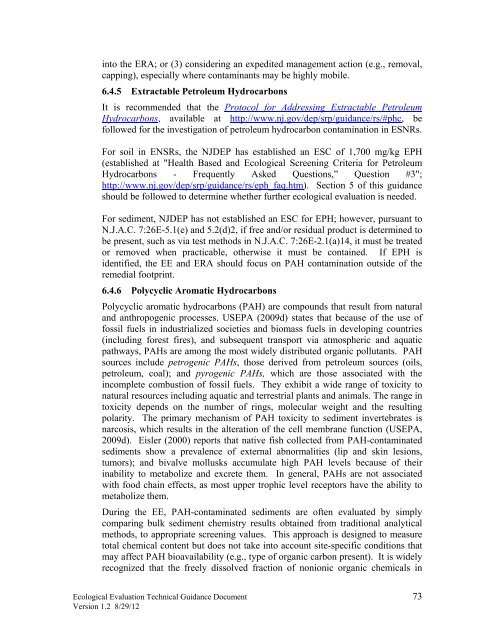Ecological Evaluation Technical Guidance - State of New Jersey
Ecological Evaluation Technical Guidance - State of New Jersey
Ecological Evaluation Technical Guidance - State of New Jersey
- No tags were found...
You also want an ePaper? Increase the reach of your titles
YUMPU automatically turns print PDFs into web optimized ePapers that Google loves.
into the ERA; or (3) considering an expedited management action (e.g., removal,capping), especially where contaminants may be highly mobile.6.4.5 Extractable Petroleum HydrocarbonsIt is recommended that the Protocol for Addressing Extractable PetroleumHydrocarbons, available at http://www.nj.gov/dep/srp/guidance/rs/#phc, befollowed for the investigation <strong>of</strong> petroleum hydrocarbon contamination in ESNRs.For soil in ENSRs, the NJDEP has established an ESC <strong>of</strong> 1,700 mg/kg EPH(established at "Health Based and <strong>Ecological</strong> Screening Criteria for PetroleumHydrocarbons - Frequently Asked Questions,” Question #3";http://www.nj.gov/dep/srp/guidance/rs/eph_faq.htm). Section 5 <strong>of</strong> this guidanceshould be followed to determine whether further ecological evaluation is needed.For sediment, NJDEP has not established an ESC for EPH; however, pursuant toN.J.A.C. 7:26E-5.1(e) and 5.2(d)2, if free and/or residual product is determined tobe present, such as via test methods in N.J.A.C. 7:26E-2.1(a)14, it must be treatedor removed when practicable, otherwise it must be contained. If EPH isidentified, the EE and ERA should focus on PAH contamination outside <strong>of</strong> theremedial footprint.6.4.6 Polycyclic Aromatic HydrocarbonsPolycyclic aromatic hydrocarbons (PAH) are compounds that result from naturaland anthropogenic processes. USEPA (2009d) states that because <strong>of</strong> the use <strong>of</strong>fossil fuels in industrialized societies and biomass fuels in developing countries(including forest fires), and subsequent transport via atmospheric and aquaticpathways, PAHs are among the most widely distributed organic pollutants. PAHsources include petrogenic PAHs, those derived from petroleum sources (oils,petroleum, coal); and pyrogenic PAHs, which are those associated with theincomplete combustion <strong>of</strong> fossil fuels. They exhibit a wide range <strong>of</strong> toxicity tonatural resources including aquatic and terrestrial plants and animals. The range intoxicity depends on the number <strong>of</strong> rings, molecular weight and the resultingpolarity. The primary mechanism <strong>of</strong> PAH toxicity to sediment invertebrates isnarcosis, which results in the alteration <strong>of</strong> the cell membrane function (USEPA,2009d). Eisler (2000) reports that native fish collected from PAH-contaminatedsediments show a prevalence <strong>of</strong> external abnormalities (lip and skin lesions,tumors); and bivalve mollusks accumulate high PAH levels because <strong>of</strong> theirinability to metabolize and excrete them. In general, PAHs are not associatedwith food chain effects, as most upper trophic level receptors have the ability tometabolize them.During the EE, PAH-contaminated sediments are <strong>of</strong>ten evaluated by simplycomparing bulk sediment chemistry results obtained from traditional analyticalmethods, to appropriate screening values. This approach is designed to measuretotal chemical content but does not take into account site-specific conditions thatmay affect PAH bioavailability (e.g., type <strong>of</strong> organic carbon present). It is widelyrecognized that the freely dissolved fraction <strong>of</strong> nonionic organic chemicals in<strong>Ecological</strong> <strong>Evaluation</strong> <strong>Technical</strong> <strong>Guidance</strong> Document 73Version 1.2 8/29/12
















